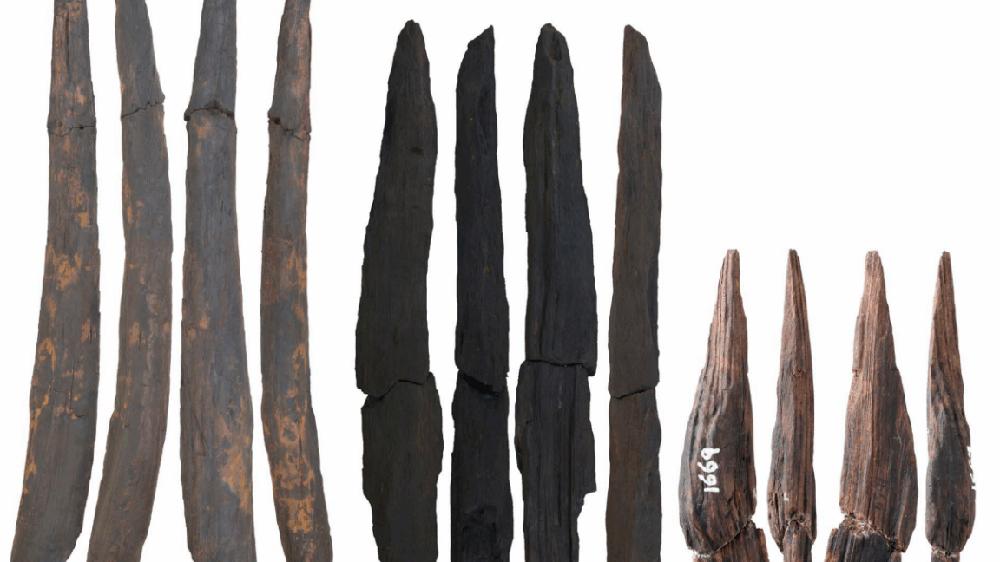Someone made very sophisticated wooden tools in China 300,000 years ago, and it might have been Denisovans or even Homo erectus.
The digging sticks, curved root-slicers, and a handful of somewhat puzzling implements were all found at a lakeshore site called Gantangqing. They are the oldest wooden tools from East Asia so far. All the previous Pleistocene tools found in the area were made from harder material like stone, bone, or antler. But logic suggests that hominins must have prepared and used softer materials as well. That thought led archaeologists to what’s called the Bamboo Hypothesis: the idea that during the Pleistocene, hominins (including our own species) might have used bamboo the way wood gets used elsewhere.
The jury’s still out on bamboo, because there’s no actual evidence of bamboo tools yet. What we now have, it turns out, are nearly three dozen tools made of wood.
Wooden tools, dig it?
Archaeologists excavating at Gantangqing (an archaeological site on the shore of Lake Fuxian in what’s now southwestern China) unearthed 35 wooden tools from layers of soil dating to around 300,000 years ago. According to Yunnan Institute of Cultural Relics and Archaeology archaeologist Jian-Hui Liu and colleagues, all 35 tools seem to have been designed, crafted, and used to harvest plants—specifically, the rhizomes, bulb-like corms, and other underground organs that many plants use to store nutrients. In a lakeshore environment like Gantangqing, surrounded by wetlands, such starchy food sources would have been available in abundance. The wooden tools suggest that whichever group of ancient hominins lived here knew which plants to harvest and which tools were best for the job.
Some of the tools were hefty two-handed implements for digging. A couple of them were similar to ones found at a 171,000-year-old Neanderthal site in Italy. All of these implements would have been strikingly familiar to hunter-gatherers of the modern Australian Bindibu, Tanzanian Hadza, or South African San people. After all, common problems (how to dig up those tasty, tasty roots) often lead to common solutions (sticks with pointed tips and rounded handles).
But a handful of the other large digging sticks don’t look like anything archaeologists have seen at other Paleolithic sites, or in the hands of modern hunter-gatherers. In Liu and colleagues’ words, they’re “probably types of digging implements not seen on other sites.”
Another handful of tools are much smaller, like the Paleolithic version of a one-handed gardening tool. These are sort of hook-shaped, formed by smoothing and shaping the crook where the base of a tree trunk met the top of a root. The inner edge of each hook is sharpened for cutting, “shows wear through use, and could have been used for slicing through roots,” write Liu and colleagues. So you can begin to see a process at work: use a two-handed digging stick like a shovel to dig down to a bundle of rhizomes, then kneel down and use your sharp hook to cut yourself a basketful for dinner.
But Liu and colleagues still aren’t sure what the hominins at Gantangqing used another group of wooden tools for. They’re small (5 to 8 centimeters long) finely carved lozenge shapes, with round sides and pointy tips worn from use—but no one alive today knows exactly what kind of use. They’re too small to be very practical for digging, but Liu and colleagues suggest that maybe these small wood lozenges could have been awls, or some sort of specialized tools for separating tangled rhizomes or roots.
The researchers recovered grains of ancient plant starches from the tips of a few of the tools, but after 300,000 years, the molecules were too degraded to tell what species of plant they'd come from.
Who made these tools?
Liu and colleagues used several methods to date the layers of sediment that held the tools, and it turns out they’re between 361,000 and 250,000 years old. The timing narrows down the potential craftspeople a bit: technically, the very earliest people we would recognize as Homo sapiens were already walking around Africa at this point, but nobody from our species had moved through the Levant and into Eurasia until around 200,000 years ago (or at least, nobody whose remains archaeologists have found yet).
That leaves a few possibilities: Denisovans, Homo heidelbergensis (the common ancestor of Neanderthals, Denisovans, and our species), or Homo erectus. All three species could have lived in the area at the time. But nobody at Gantangqing left behind any convenient, readily identifiable bones along with their wooden tools, stone tools, and butchered animal bones (so inconsiderate of them), making it hard to pin down exactly which species these 300,000-year-old hunter-gatherers belonged to.
Homo erectus had been in Asia for more than a million years by the time Gantangqing’s lakeshore was occupied; the oldest Homo erectus fossils in Asia are from Indonesia and date back 1.8 million years. They also stuck around until quite recently. In caves at a site called Zhoukoudian, outside Beijing in eastern China, Homo erectus remains date to sometime between 700,000 and 200,000 years ago (there’s still a lot of debate on exactly how old the site is).
All of that means that Homo erectus’ presence in the region overlaps the age of the wood tools at Gantangqing. And the stone tools found nearby are fairly simple cores and flakes that don’t rule out Homo erectus as their makers. Archaeologists haven’t unearthed evidence of Homo erectus making or using sophisticated wooden tools like this, but for a species that managed to harness fire and cross miles of ocean, it’s not too wild a speculation.
On the other hand, we know that Denisovans were probably in the area, too, or at least not too far away. A recently identified Denisovan skull from Harbin, China, is 146,000 years old but bears a striking resemblance to other hominin skulls from sites all over China, which range from 300,000 to 200,000 years old. And making finely crafted wooden tools fits with everything we know about Denisovan capabilities.
Then there’s Homo heidelbergensis, the direct ancestor of Denisovans. In fact, it’s a little hard to tell where hominins stop being Homo heidelbergensis and start being Denisovans, or even whether the distinction matters. It's a problem paleoanthropologists refer to as the “muddle in the Middle,” since both species date to the Middle Pleistocene. So if Homo erectus and Denisovans are in the running, so is Homo heidelbergensis, by default.
And unless someone finds a telltale skull nearby or another very similar toolkit at a site with telltale skulls to consult, we may not know for sure.
Science, 2023. DOI: 10.1126/science.adr8540 (About DOIs).

 Inno a Babilonia: l'AI svela un testo di mille anni fa
Inno a Babilonia: l'AI svela un testo di mille anni fa